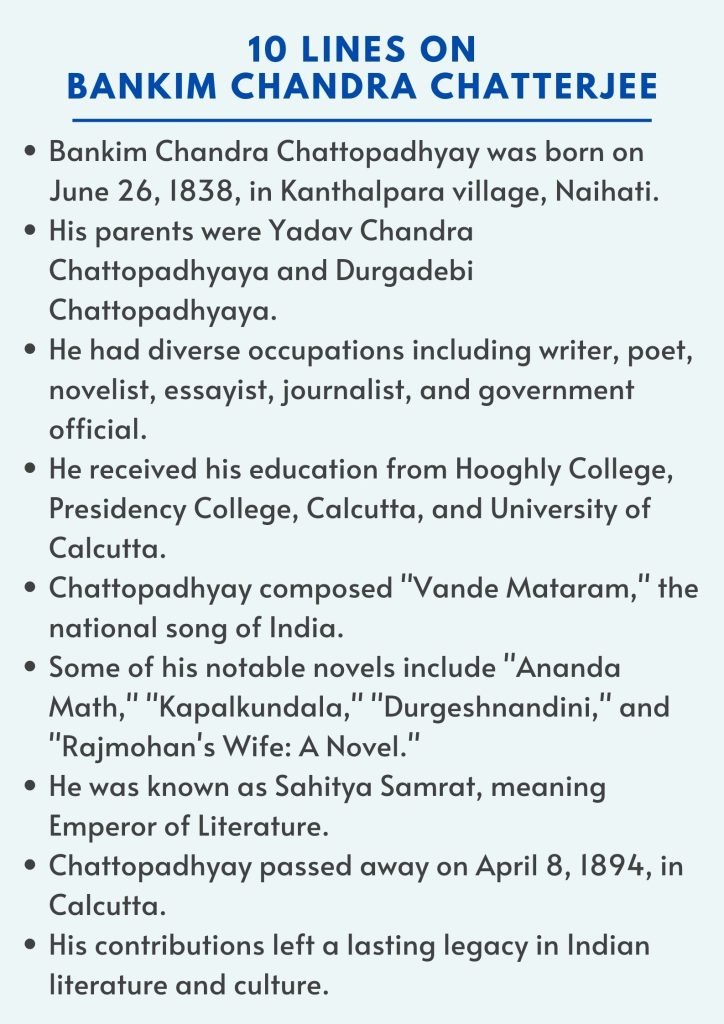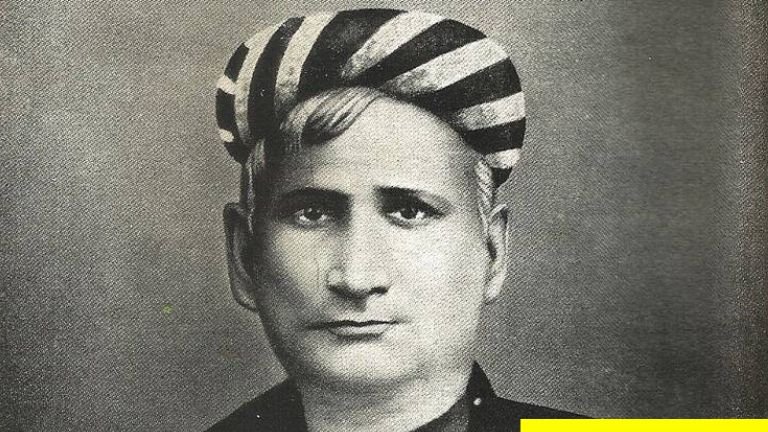Essay on Bankim Chandra Chatterjee: Bankim Chandra Chatterjee, a literary legend of India, was born in 1838. More than just a poet, he was a wordsmith who mastered novels, essays, and journalism too. But his most iconic creation is surely “Vande Mataram,” the stirring song that became India’s national anthem. Nicknamed “Sahitya Samrat” (Emperor of Literature), Chatterjee’s influence on Indian writing is undeniable. Though he passed away in 1894, his captivating stories and powerful words continue to inspire readers today.
We at Learninger, presented 10 Lines on Bankim Chandra Chatterjee with Short and Long Essays. These paragraphs or essays are written on simple English so that you can memorize it easily.
10 Lines on Bankim Chandra Chatterjee

- Bankim Chandra Chattopadhyay (also Chatterjee), was a literary giant of India.
- Born in 26 June 1838 in Naihati, West Bengal, he excelled in various forms of writing.
- His father was Yadav Chandra Chattopadhyaya and mother was Durgadebi Chattopadhyaya.
- A novelist, poet, essayist, and journalist, he left an indelible mark on Bengali literature.
- He is best known for composing “Vande Mataram,” India’s national song.
- His novel “Anandamath” is a landmark work, inspiring Indian independence fighters.
- Educated at prestigious institutions, he was among the University of Calcutta’s first graduates.
- He even served as a government official while pursuing his literary endeavors.
- Revered as “Sahitya Samrat” (Emperor of Literature), his influence on Indian literature is immense.
- Sadly, he passed away in 1894, leaving behind a rich literary legacy.
Basic Information about Bankim Chandra Chatterjee
| Name | Bankim Chandra Chatterjee (also Chattopadhyay) |
| Birth Date and Place | 26 June 1838 in the Village of Kanthalpara in the town of North 24 Parganas, Naihati |
| Parents | Father – Yadav Chandra Chattopadhyaya and Mother – Durgadebi Chattopadhyaya |
| Occupation | Writer, Poet, Novelist, Essayist, Journalist & Government official |
| Education | Educated at Hooghly College and at the University of Calcutta |
| Composer | Vande Mataram (National Song of India) |
| Novels/ Books | Ananda Math, Kapalkundala, Durgeshnandini, Rajmohan’s Wife: A Novel etc. |
| Known as | Sahitya Samrat (Emperor of Literature) |
| Died on | April 8, 1894, Calcutta |
Paragraph on Bankim Chandra Chatterjee
Bankim Chandra Chattopadhyay was born on 26 June 1838 in the village of Kanthalpara, Naihati, North 24 Parganas. His father was Yadav Chandra Chattopadhyaya, and his mother was Durgadebi Chattopadhyaya. He went to Hooghly College, Presidency College in Calcutta, and the University of Calcutta, where he graduated early.
Chattopadhyay was a writer, poet, and novelist, known for his famous composition “Vande Mataram,” which became India’s national song. Some of his well-known novels include “Ananda Math,” “Kapalkundala,” “Durgeshnandini,” and “Rajmohan’s Wife: A Novel.”
He was affectionately called “Sahitya Samrat” or Emperor of Literature for his remarkable literary skills. Apart from writing, he also worked as a journalist, essayist, and government official. Bankim Chandra Chattopadhyay passed away on 8 April 1894 in Calcutta, leaving behind a rich legacy that continues to inspire generations.
Short Essay on Bankim Chandra Chatterjee
Bankim Chandra Chattopadhyay, also known as Bankim Chandra Chatterjee, was a famous writer, poet, and novelist from India. He was born on June 26, 1838, in the village of Kanthalpara, located in the town of North 24 Parganas, Naihati. His parents were Yadav Chandra Chattopadhyaya and Durgadebi Chattopadhyaya.
Bankim Chandra Chattopadhyay had a diverse career. He worked as a writer, poet, novelist, essayist, journalist, and government official. Bankim received his education from various esteemed institutions, including Hooghly College, Presidency College in Calcutta, and the University of Calcutta. He was among the earliest graduates of the University of Calcutta.
One of Bankim Chandra Chattopadhyay’s significant contributions to Indian literature is the composition of “Vande Mataram,” which later became the national song of India. This song played a crucial role in the Indian independence movement, inspiring many with its patriotic fervor.
As a novelist, Bankim Chandra Chattopadhyay penned several notable works, including “Ananda Math,” “Kapalkundala,” “Durgeshnandini,” and “Rajmohan’s Wife: A Novel.” His novels often explored themes of nationalism, societal issues, and historical narratives, making him a celebrated figure in Indian literature.
Bankim Chandra Chattopadhyay earned the title of “Sahitya Samrat,” which translates to “Emperor of Literature,” owing to his immense contributions and influence in the literary world.
Sadly, Bankim Chandra Chattopadhyay passed away on April 8, 1894, in Calcutta. Despite his physical absence, his literary works continue to inspire generations of readers and writers, leaving behind a lasting legacy in Indian literature and culture.
Long Essay on Bankim Chandra Chatterjee
Here’s a long essay on Bankim Chandra Chatterjee in about 500 words.
Remembering Bankim Chandra Chattopadhyay: The Literary Luminary
In the vast tapestry of Indian literature, certain luminaries shine brightly, leaving an indelible mark on the literary landscape. Among them stands Bankim Chandra Chattopadhyay, a towering figure whose literary contributions continue to resonate with readers even today. On the occasion of his birth anniversary, let’s take a moment to remember and celebrate the life and works of this esteemed writer, poet, and novelist.
Early Life and Education
Bankim Chandra Chattopadhyay was born on 26 June 1838 in the quaint village of Kanthalpara in Naihati, North 24 Parganas. His upbringing was shaped by his father, Yadav Chandra Chattopadhyaya, and mother, Durgadebi Chattopadhyaya. From a young age, Chattopadhyay displayed a keen intellect and a passion for literature.
He pursued his education with fervor, attending prestigious institutions such as Hooghly College, Presidency College in Calcutta, and the University of Calcutta. It was during his formative years that he honed his literary skills, laying the foundation for his future endeavors.
Literary Legacy
Chattopadhyay’s literary oeuvre is vast and varied, encompassing novels, poems, essays, and journalistic writings. However, it is perhaps his composition “Vande Mataram” that etched his name in the annals of history. This stirring hymn, penned in Sanskritized Bengali, became a rallying cry for India’s freedom struggle and later achieved the status of the national song of India.
Among his notable novels are “Ananda Math,” “Kapalkundala,” “Durgeshnandini,” and “Rajmohan’s Wife: A Novel,” each weaving intricate narratives that captivate readers with their depth and complexity. Chattopadhyay’s ability to portray the socio-cultural milieu of his time with vivid detail earned him the epithet of “Sahitya Samrat” or Emperor of Literature.
Beyond Literature
While Chattopadhyay’s literary prowess is widely celebrated, his contributions extended beyond the realm of literature. He served as a journalist, essayist, and government official, demonstrating a multifaceted talent that transcended boundaries.
Legacy and Remembrance
Bankim Chandra Chattopadhyay passed away on 8 April 1894 in Calcutta, but his legacy endures through his timeless works and enduring influence on Indian literature. His writings continue to inspire and resonate with readers across generations, reminding us of the power of words to shape hearts and minds.
As we commemorate his birth anniversary, let us pay tribute to this literary luminary whose words continue to echo through the corridors of time, stirring the souls of all who encounter them. In honoring Bankim Chandra Chattopadhyay, we celebrate not just a writer, but a beacon of wisdom and enlightenment whose legacy shines bright even today.
